One of Shiraz’s oldest mosques, Nasir-ol Molk Mosque is unquestionably one of Iran’s most picturesque locations(shiraz top attractions). The Nasir-ol Mulk Mosque, often referred to as the Rainbow Mosque or Pink Mosque, first appears to be a typical Islamic mosque, but when the sun rises, the architectural design transforms the mosque into a massive kaleidoscope.
The carpets on the floor and the walls are painted with hundreds of different colors by the sunlight that enters via mosaic windows. Plan your visit for early in the morning since the magic will disappear in a few hours.
An Iran must-do experience and a must-include on any traveler’s itinerary to Iran is witnessing the light pass through the Nasir ol-Mulk Mosque. Intrigued? We shall discuss this mosque’s notable features, history, and architecture in more detail here in this blog. In addition, we’ll discuss the ideal moments for visiting the Pink Mosque and taking breathtaking pictures there. You may observe the enchanted light show in the vaults and halls’ vibrant hallways in this manner.
History of Nasir ol-Mulk Mosque

Mirza Hassan Ali Khan gave the order to build the Nasir ol-Mulk Mosque about 150 years ago, during the Iranian Qajar era. When that time came, the governor of Fars Province was Mirza Hassan Ali Khan, also known as Nasir ol-Mulk. According to reports, this rich man had numerous properties in the area of Shiraz. He left all of his possessions to charities after his passing.
His descendants still donate all of the mosque’s earnings to charitable causes today. All of the Nasir al-Mulk Mosque’s expenses, however, were covered by tithes. Muslims in Islam are required to pay tithes as a percentage of their income in order to support social advancement.
About 12 years were spent on the Nasir ol-Mulk Mosque building. However, 44 years later, it installed its renowned stained glass windows. We’ll go into more depth about the Pink Mosque’s many components and architectural elements below. It’s interesting to note that Nasir ol-Mulk Mosque formerly belonged to a larger complex. This complex had a home, storage, and a bathhouse. The remaining portions of the complex are not visible at this time.
The Architecture and Design of Nasirolmolk Mosque

A 2890 square meter underlying area and 2216 square meters make up the Nasir-ol Mulk Mosque. The tiling and muqarnas that comprise two of the mosque’s most recognizable features, make it the most valuable structure in this regard.
Nasir-ol Mulk Mosque has an intriguing feature in that, in contrast to all other Iranian mosques, it is devoid of a dome, which is symbolic of the fact that it was a private edifice and that few people visited it.
This mosque has really beautiful and distinctive tiling.
You won’t find a tiling like this anywhere else on the globe. Another factor contributing to its beauty is the usage of pink as the main hue, which is unique to this mosque in comparison to other Iranian mosques.
The mosque is known as the Pink Mosque because of the stunning pink and purple tilework that adorns the entryway.
The intricate architecture of the mosque, which turns sunlight into brilliant strands of sunlight, and the inclusion of striking colored glassware have made it an unrivaled majesty.
European artworks are also used to embellish each floor’s ceiling. When visiting Nasir-ol Mulk Museum, be sure not to miss them. You just need to lift your head, that’s all!
The Entrance Portal of Nasirolmolk Mosque
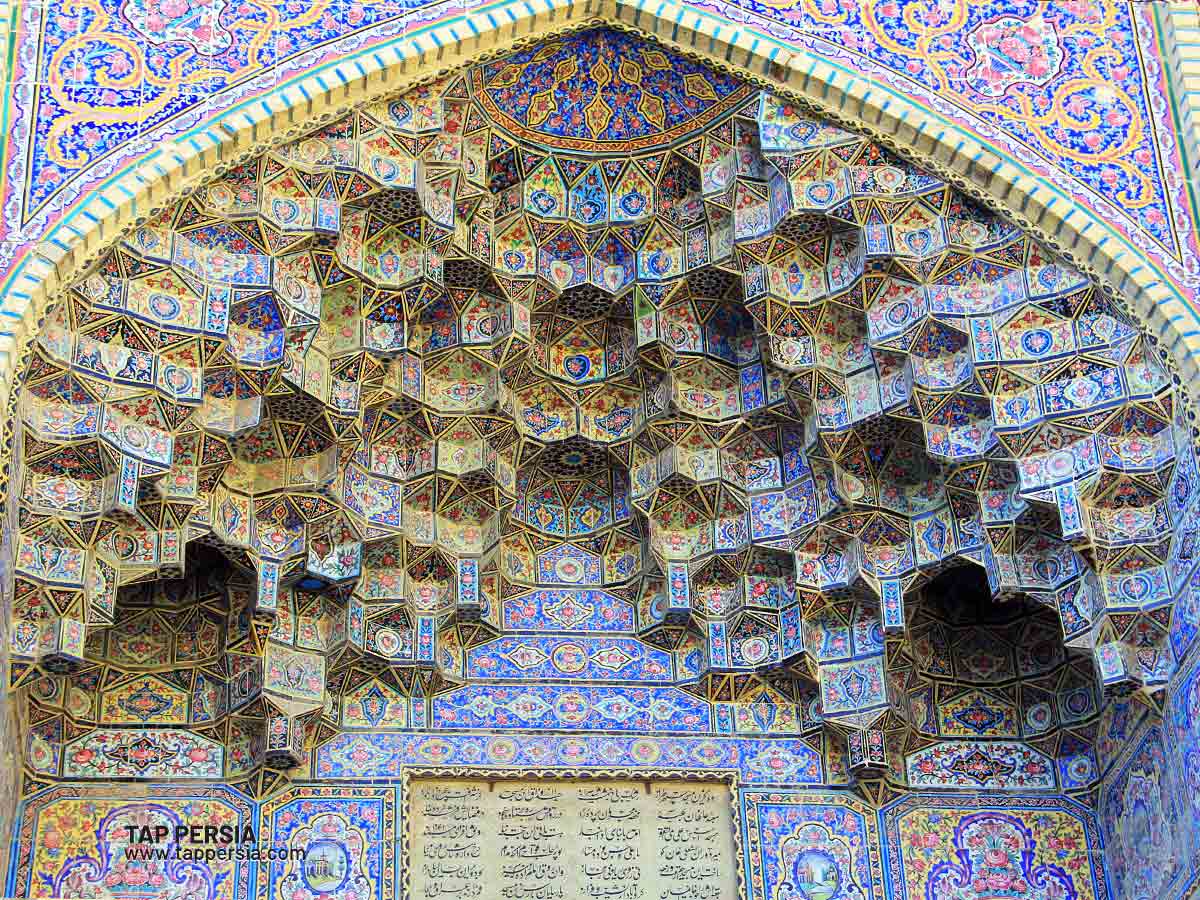
A huge vault over the entryway features seven-colored tiles adorning the ceiling. The entry arch of the Nasir-olmolk Mosque features stunning Mogharnas constructed of seven-color tiles, and its arch is formed of wheat stone. Two substantial wooden doors serve as the mosque’s entrances, and a Shorida Shirazi poem commemorating the mosque’s function and the year it was completed is visible on top of each.
The Eastern Shabestan (Prayer Hall) of Nasir-olmolk Mosque
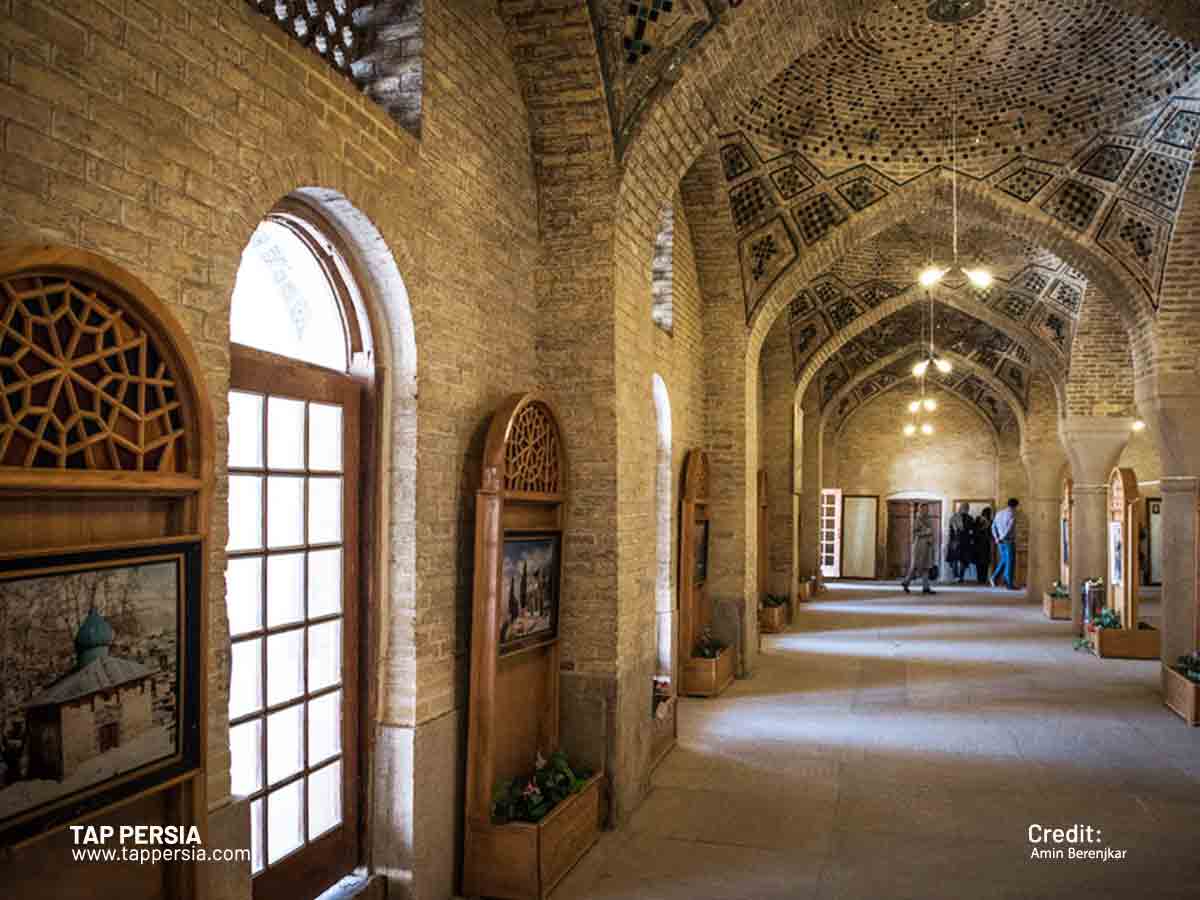
This nave’s masonry and art were influenced by the Vakil Mosque and the Moshir Moshir Shiraz Mosque. And it is constructed of incorporated Gandomak stone. Beautiful tiles cover the nave’s arch and walls, and the third line of the Quran is included in the decoration of the sky, as well as globate and other Muslim symbols. Both the stone of the altar’s floor and the nave’s floor, which is covered in turquoise tiles.
Furthermore, it starts at the nave’s base. Made of marble. Beanie between the nave tweezers rises and drapes just a little. It’s summer nave that you see here.
Consequently, there is a door in this nave that leads to a well. This passageway is known as a cow or a cattle well. A pond and a passageway are also present at this location.
The Endowment Museum is currently located in the eastern nave. There are writings along the northern passageways. Additionally, the poem that follows has a stunning Nastaliq line that reads, “We see no survival except the owner of heart one day bestows His mercy on the Masters of prayer.”
Above importantly, the names of the architects Muhammad Hassan and Professor Mohammad Reza, as well as the dates that they began work on the project in 1293 AH and completed it in 1305 AH, are recorded at the conclusion of the document.
Tāq-e Marvārid (Pearl Arch) of Nasir-almolk Mosque
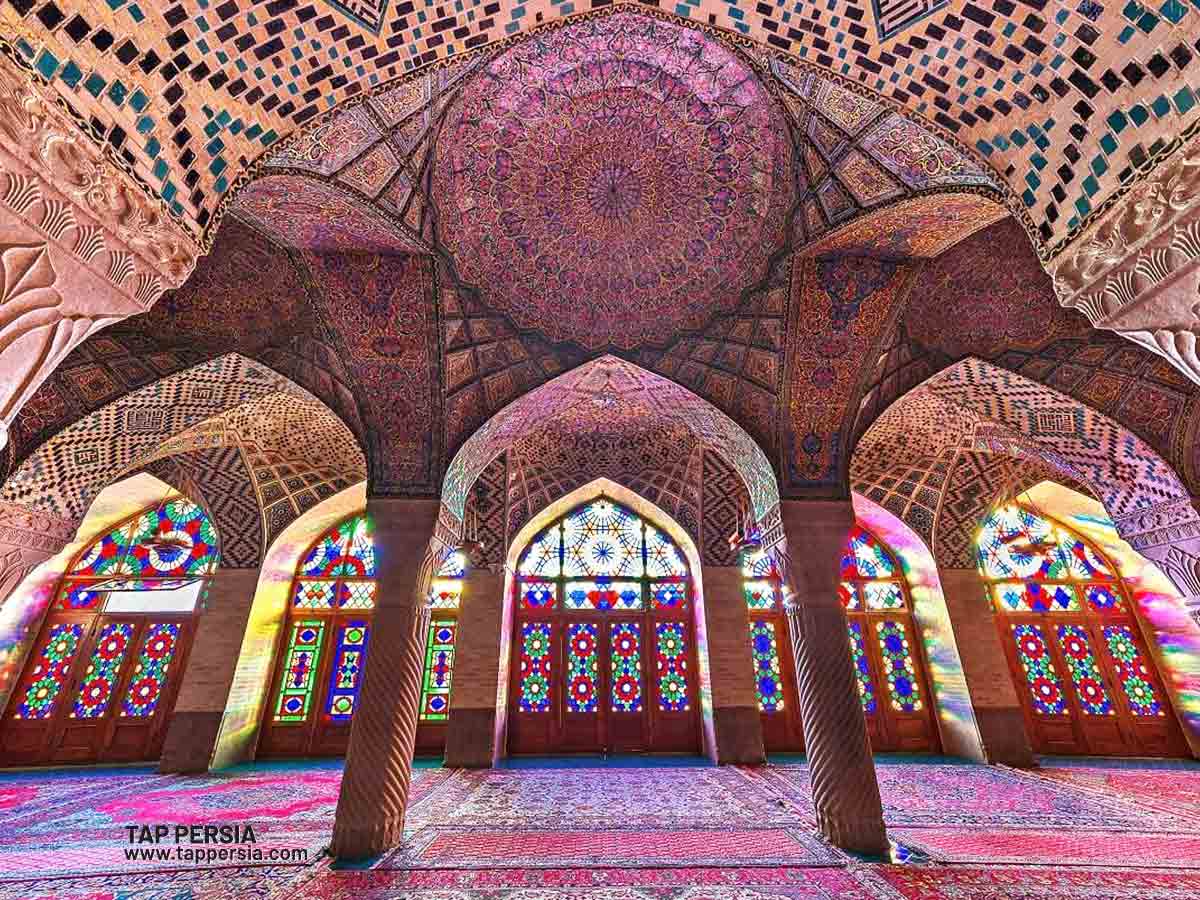
The Nasir ol-Mulk Mosque has two major iwans, often known as entrances. Each of these gateways has its own architectural style and vaulting material. Despite the fact that the two portals are facing one another, their features and designs are really asymmetrical. One of the Pink Mosque’s most attractive characteristics is the gateway on the north side.
In addition to the distinctive tile work, this Portal boasts a particular kind of vaulting. Five sculptures that resemble pearl shells may be seen on the ceiling of this section of the Nasir ol-Mulk Mosque. This is the reason why this gateway has earned notoriety through time as the Pearl Arch.
Due to the presence of two minarets, the southern iwan of the mosque may be distinguished from the northern iwan. Additionally, this vault features distinctive tile patterns and unique vaulting.
Go to the Nasir ol-Mulk Mosque in the afternoon if you want to take a stunning photo of the Pearl Arch since the light illuminates it and makes it even more stunning.
Explore Iran’s hidden historical gems in “The Hidden Gems of Iran: 10 Must-Visit Historical Sites” by clicking on the link and uncover the country’s rich cultural heritage.
The Gav Chah in Nasir-almolk Mosque
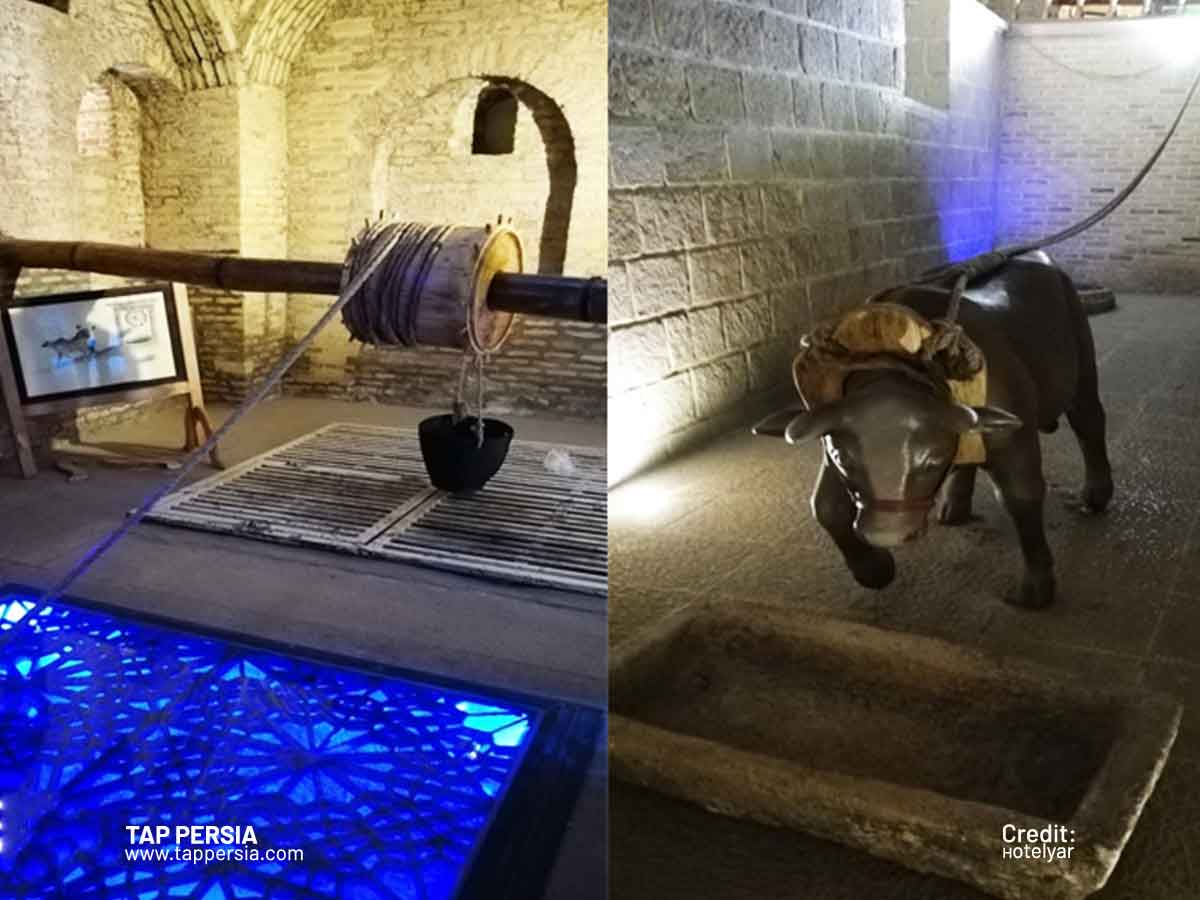
A well called “Gav Chah” may be found inside the Madras, which is hidden behind the east Shabestan. The animals used to transport water were kept in this area. To transport water to the “howz”, they would utilize these animals, which were mostly cows. In order to be clean and enter the Shabestans and begin worshipping, people utilize this water for ablution. These days, however, it is just used as a portion of the mosque that guests may see because it no longer functions.
Imamzadeh-ye Zanjiri (shrine) in Nasir-almolk Mosque
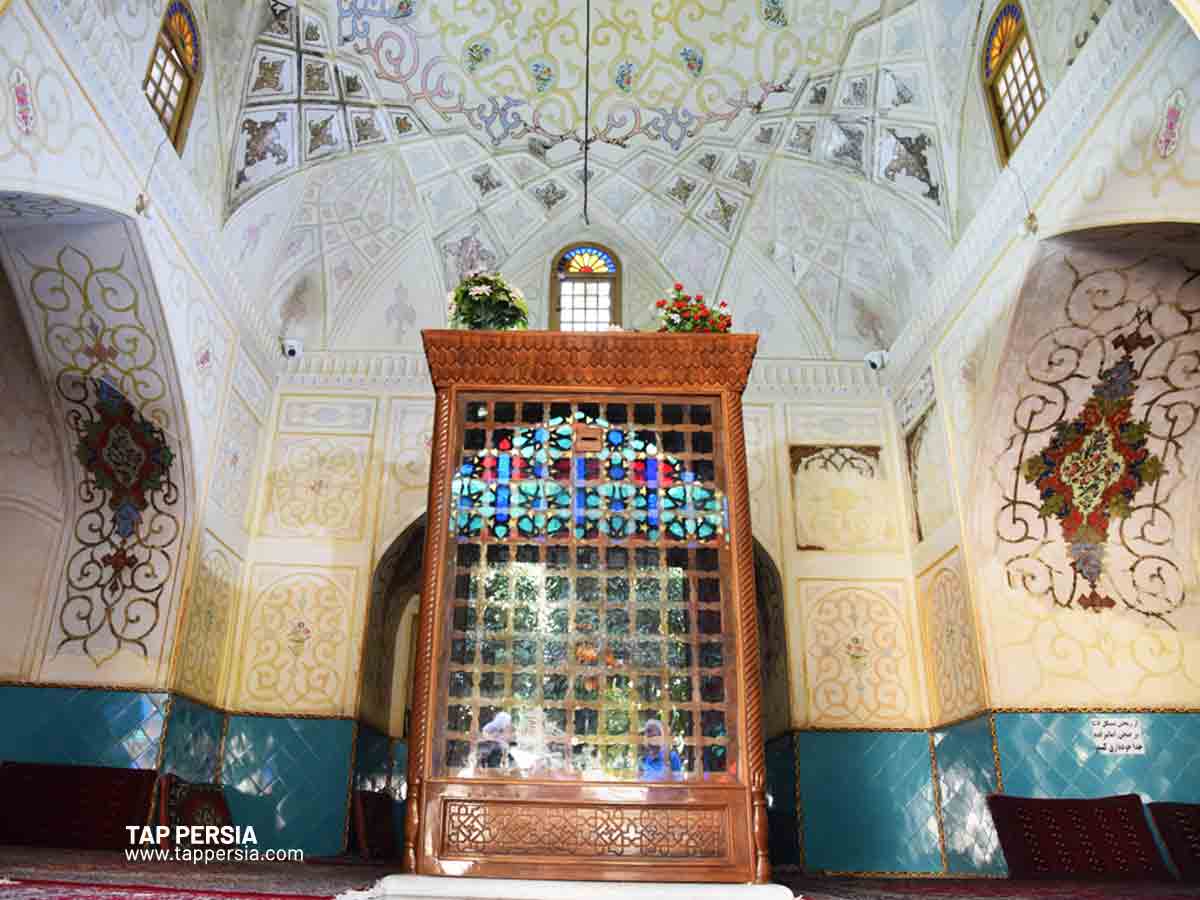
Another section of the Nasir-ol-Mulk Mosque is the Imamzadeh-ye Zanjiri. At that time, people used to bind guilty parties and criminals to certain locations inside this Imam Zade. There was a superstitious notion that if a person was not actually guilty, the shackles would naturally release and they would be let free.
The Western Shabestan (Prayer Hall) of Nasir-olmolk Mosque
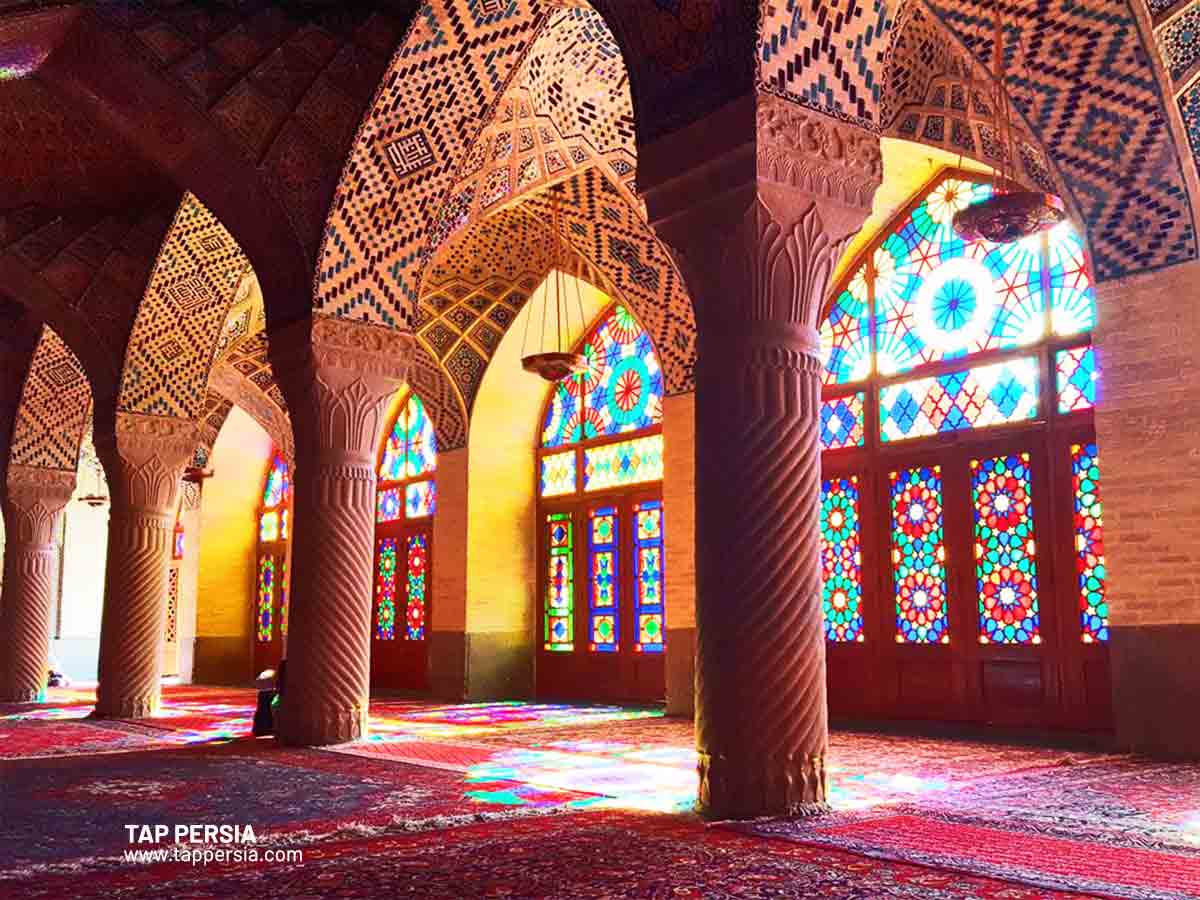
It is more lovely since the Western nave is brick-coated. Stone columns with spiral designs support the nave’s arch. The intents of the twelve imams are represented by the twelve numerals in these columns, which are situated in two rows of six.
Furthermore, it connects to the mosque’s apron by seven portals with seven wooden doors and decorative glass. The winter nave is another name for this one. The courtyard is divided from the porch by eight arches, which are 6 meters wide and located in front of the nave. possessing seven brick circles. Maps of flowers and shrubs as well as words from the Quran are tiled on these ridges and the foreheads of the arcs.
The Beauty of the Stained Glass Windows
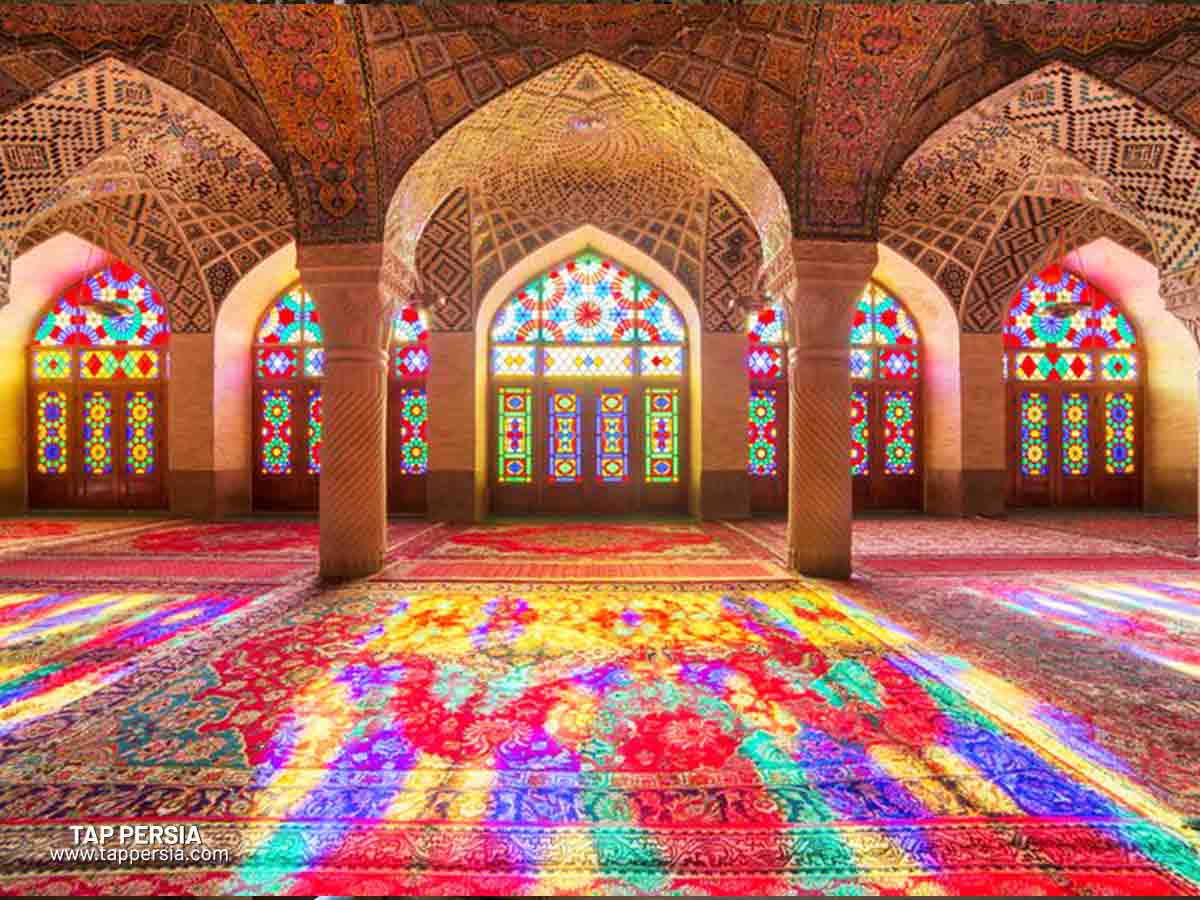
Utilizing Orsi in the mosque’s construction is another intriguing distinction from other mosques. Stained glass is what makes up Orsi. The majority of churches across the world use stained glass, which is a product of Syria. In the seventh century, people made the discovery of stained glass in Syria. Jabir ibn Hayyan detailed how to produce this sort of glass in his book “The Book of the Hidden Pearl.”
In actuality, Orsi windows are made of a mix of wood and colored glassware.
The Safavid and subsequent Qajar eras’ architecture is notable for its use of these windows. Orsi glass differs from stained glass seen in churches in that it was employed in Persian architecture as a source of sunlight that was filtered. However, it served mostly as an illustration for figures and shapes that the designers intended to stand out in churches.
The Significance of Nasir-olmolk Mosque to the Local Community
The world’s Islamic architecture includes Iran mosques. Thus, as places of worship, these mosques serve as a symbol of the monotheistic nature of Islam and its oneness. In Iran, mosques served as gathering places for both religious rituals and efforts to advance society. These mosques have to have a warm and meditative ambiance for this purpose.
Visitors that come to the Nasir ol-Mulk Mosque would have felt a sense of belonging in Iran mosques because of the unique environment. Shiraz, one of Iran’s Islamic Cities, and its Nasir ol-Mulk Mosque were both examples of this. A sense of amazement and then humility were intended to be felt by visitors to this ancient mosque. While being functional, this mosque also had a beautiful appearance.
Nasir ol-Mulk Mosque is characterized by floral designs, the presence of water, and the use of natural light.
How to Visit Nasirolmolk Mosque
On Lotfali Khan Zand Street, in the Gode Aaraban District, the NasirolMolk Mosque is located on Nasir ol-Mulk Alley. By taking Shiraz’s subway line 1, you may travel to the Pink mosque. After that, exit at Vali Asr station. The distance via cab to the mosque is just 1.5 kilometers from there. You can likewise board the Vali Asr bus and exit at the Chaharrah Moshir bus stop. In Shiraz, you may also find taxi stands and online taxi apps.
As you immerse yourself in the enchanting beauty of the Nasir ol-Mulk Mosque, known for its stunning stained glass and intricate design, extend your journey through Iran’s spiritual architecture. Explore the diversity and splendor of Iran’s mosques, each with its own story and architectural marvels, reflecting the rich tapestry of Islamic art and culture.
What is the Best Time to Visit Nasir-olmolk Mosque
It is ideal to visit Nasir-ol Mulk Mosque from the middle of October till the beginning of winter. This is because of the oblique sunlight angle, which produces the best lighting for photographing pictures. Being at the mosque between 7:00 and 9:00 in the morning when the light is at its brightest can help you capture the perfect shot. Additionally, you should visit the mosque in the afternoon when the sun is directly shining on it and creates such a stunning perspective if you want to capture the Pearl Arch in a breathtaking shot.
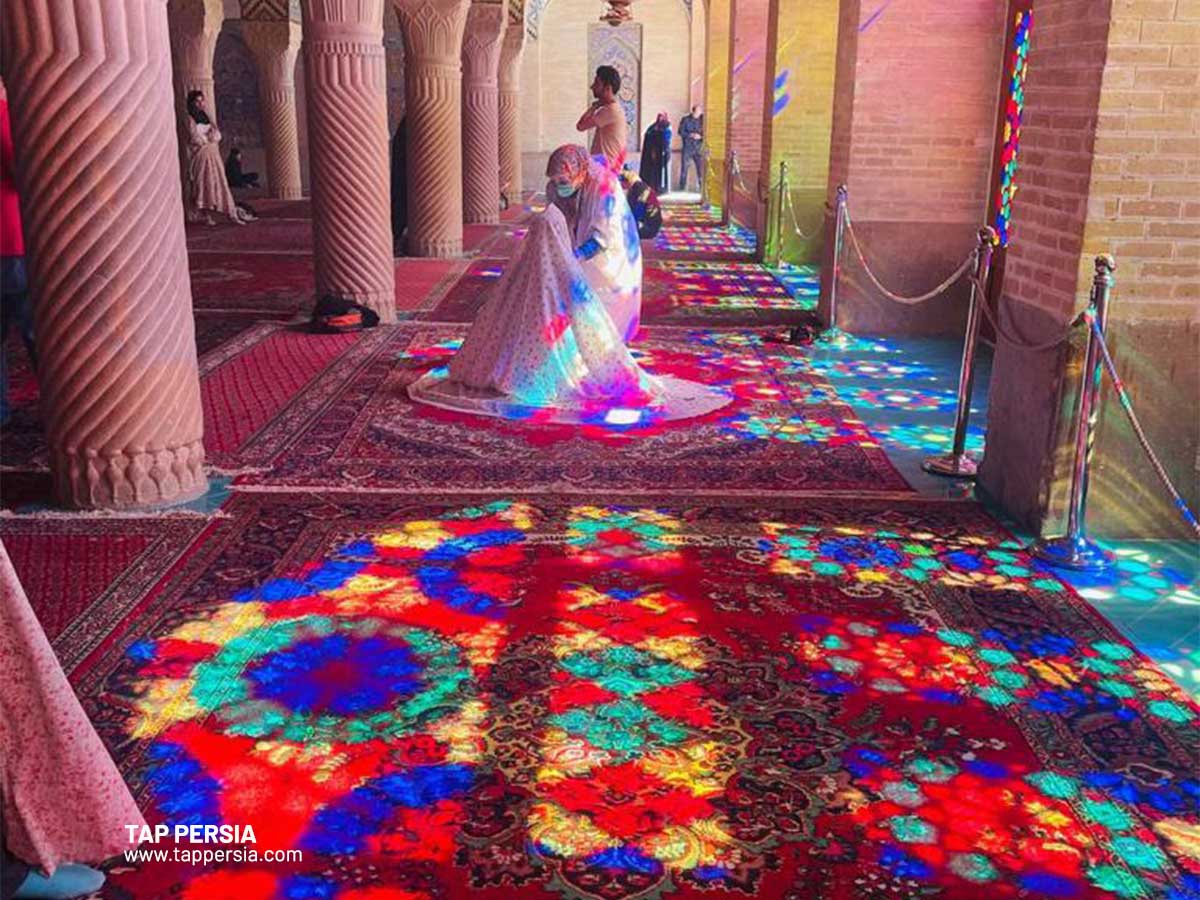
What is Nasir al-Mulk mosque known for?
It is referred known as the “Pink Mosque” because of the large number of pink tiles that adorn the ceiling. The mosque is best visited in the morning when the sun is reflecting off the stained-glass patterns on the floor.
Where is Nasir al-Mulk mosque from?
The Nasīr al-Mulk Mosque is in Shiraz, Iran.
Who made Nasir al-Mulk mosque?
Three men, Mohammad Hasan Memar, Mohammad Reza Kashipaz, and Mohammad Hosseini Naqqash Shirazi, were responsible for the designs.
How much is the entrance to Nasir al-Mulk mosque?
For tourists from outside Iran, Nasir al Mulk Mosque’s admission charge is around 150,000 IRR (Iran site entrances fee).

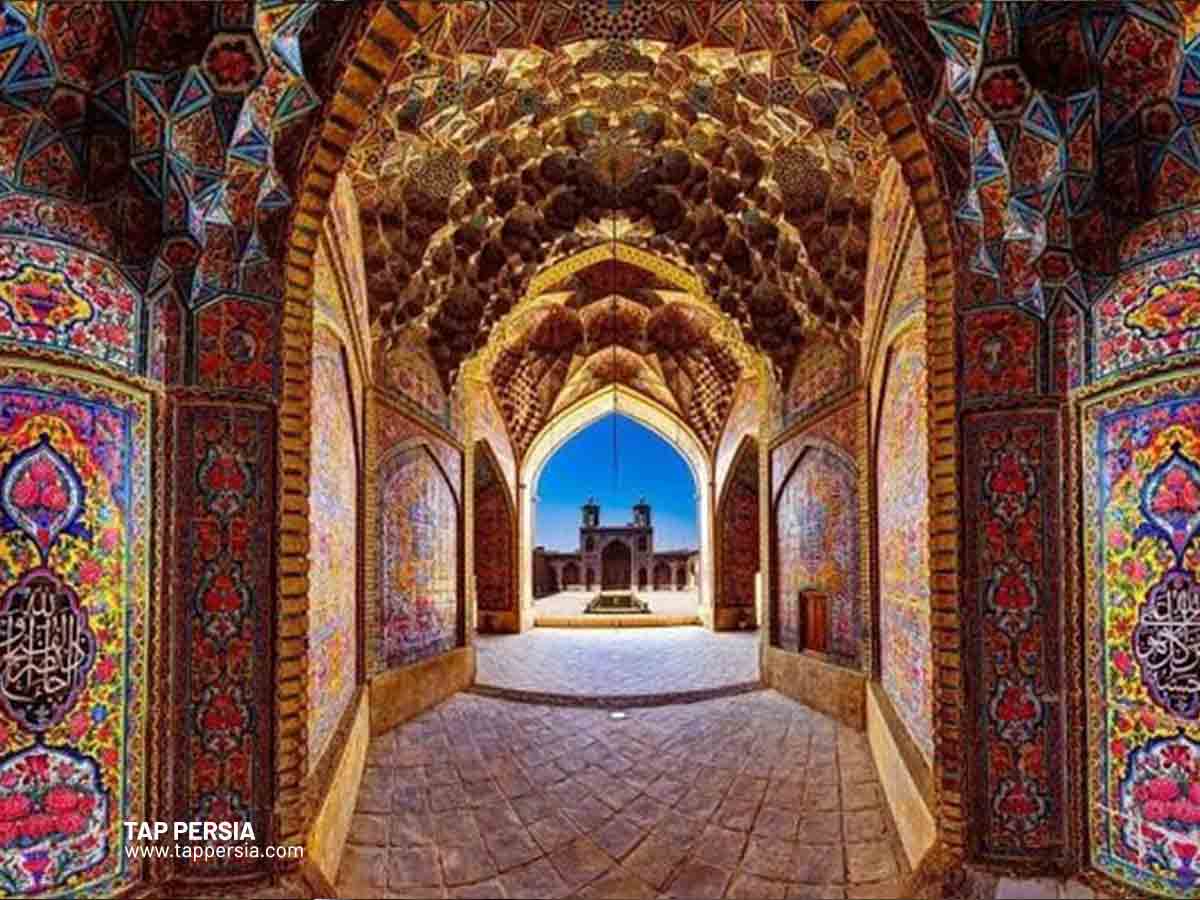


Comment (0)